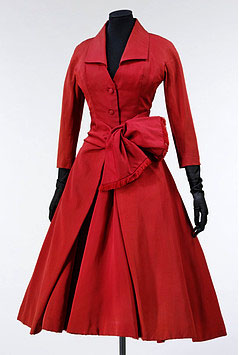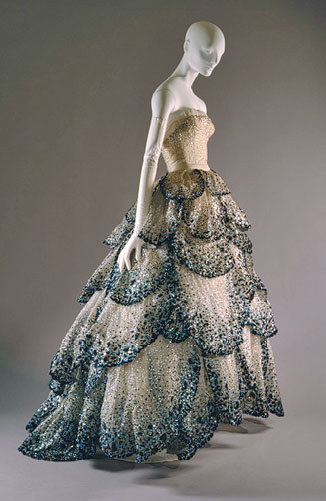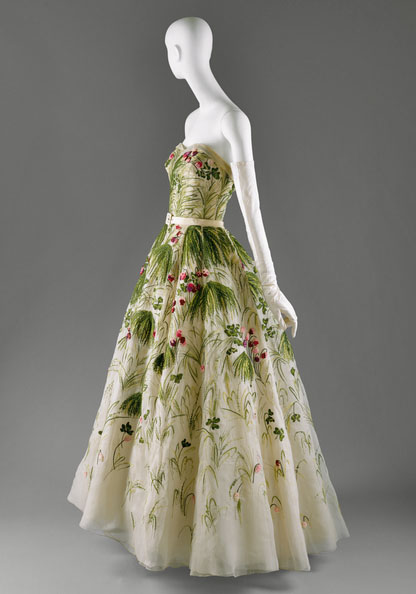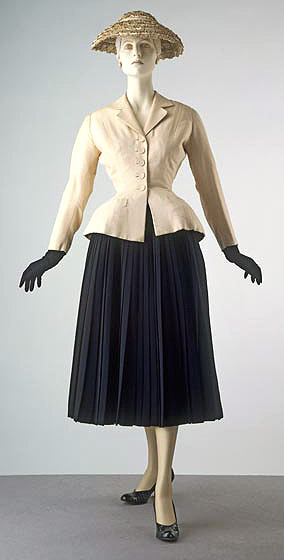Christian Dior – Structural Designer
Christian Dior (1905-1957) French

Christian Dior originally wanted to become an architect, but was instead directed by his parents to pursue a diplomatic career. Even when he finally became a fashion designer, he did not leave those architectural desires and instincts behind. He used solid, rigid construction to achieve his delicate-looking “femme-fleur” look, sometimes requiring up to 15 yards of fabric for the skirts.

Christian Dior appeared on the scene after World War II, at a time when women were craving luxury and the excess of fabric, trim, and dyes were again possible because wartime rationing had ended. He believed that he “…designed clothes for flower-like women, clothes with rounded shoulders, full feminine busts, and willowy waists above enormous spreading skirts…” as a contrast to the drab colors and masculine-styled angular clothing that had been worn by women in the past few years during the war. Some thought his new silhouette that emphasized the curves of the women who wore it was also in sympathy with the new need to increase the nation’s birthrate after the war.

Dior never learned to sew or even cut a dress; therefore, the sketches he presented to his team were not always reproducible. He would sometimes assign the same sketch to several teams and then select the muslin that most resembled what he had pictured in his mind.
The House of Dior was in business from 1946 to 1957, before his sudden death of a heart attack. However, his house was able to produce 70 collections in those ten years. Please note that a draft collection for Dior could originally consist of 175 outfits, which over time would be edited down to what would finally appear on a runway.
Hollywood connection: He designed the off-screen clothing for actresses Claudette Colbert, Marlene Dietrich, and Irene Dunne.

Home sewing connection: Licensed designs for the Paris Original series for the Vogue pattern company.

His style, innovations, and influence on fashion:
- The New Look; known in France as the Corolle (ring of petals) line, was a longer skirt with a smaller waistline silhouette presented in 1947.

- The now iconic ensemble from the New Look collection, the “bar suit”, is one of the most referenced pieces in fashion.
- As part of his training, the young Dior freelanced for Elsa Schiaparelli and Cristobal Balenciaga.
- Dior used boned corsets, rounded, sloping shoulders, built-in petticoats, and hip pads to create the understructure and curved stand-away shape to his garments.

- Some of his collections; the H-line in 1954, A-line, and the Y-line in 1955 were named for the letters that resembled the silhouettes formed by the clothes. The term and shape for the A-line is still known and used to this day.
- The Lily of the Valley was Dior’s favorite flower, the dominant scent behind his fragrance Diorissimo, and the name of his 1954 spring collection, known as Muguet in French.
Images: The Metropolitan Museum of Art, New York, NY.
Sources: Dressmakers of France (1956) Mary Brooks Pickens, Dora Loues Miller; Secrets of the Couturiers (1984) Frances Kennett; Fashion (2003) Christopher Breward; The World’s Most Influential Fashion Designers (2010) Noel Palomo-Lovinski.

 Sign In
Sign In

Comments
Mandy
January 12, 2011 #
So much detailed work in those ball gowns! So beautiful though. The thought of completing all the beading in Junon……. The dress looks wonderful.
I find it extraordinary that so many designs were drafted before each collection was put together. His styles must have brought a very welcome breath of fresh air to the fashion world after World War II.
NancyDaQ
January 12, 2011 #
Beautiful! I have to admit I prefer the dresses and gowns to his suits, although both types of garments are amazing. Truly visionary.
Ashley
January 12, 2011 #
Absolutely stunning, I’ve always loved Dior.
Julie
January 12, 2011 #
Such beautiful designs and so complimentary to a real woman’s (vs stick insect’s) figure.
Carlotta
January 12, 2011 #
I’m crazy of this Avedon photograph, nothing represents better the house of Dior to me : the splendour, the spectacular, even the slight absurdity… I prefer the more ambiguous Saint-Laurent, but these gowns are really magnificent.
Did you know that one of the other reasons behind the New Look line is that it required much, much more fabric than the former silhouettes, much to the advantage of manufacturer Boussac, Dior’s sponsor?
Nathalie
January 13, 2011 #
Wonderful as usual, thank you Lisa!
They had a Junon at the Dior Museum this summer and it was instantly my favourite dress of the exhibition. Although the beading looks black and blue along the edges of the petals, it is in fact shot with random touches of blood red. It is absolutely stunning.
yihmcqb
April 12, 2011 #
V8iFOI zvjitwbbwfpi
Photographer
January 21, 2012 #
I see you have many photos on your blog that have been borrowed from various vintage clothing sites, auction houses, and museums. Please note that is appropriate to credit the source/owner of the image when borrowing someone else’s photography to illustrate your blog.
Ginger & Smart
February 27, 2012 #
The gowns are beautiful.
Lynn Ceteras Huerta
April 13, 2012 #
Lovely fashion pictures; the red bow coat caught my eye. Thank you for your illustrated write-up about Christian Dior!
Lynn
Chris
March 15, 2014 #
The red bow coat caught my eye. Would make a wonderful “Mother of the Groom” outfit. Is there a pattern for this? (somewhere,lol)